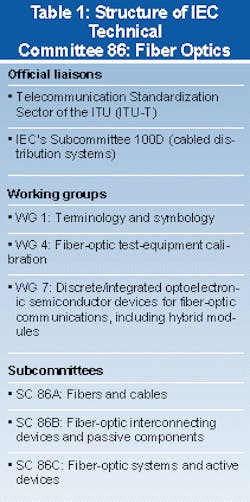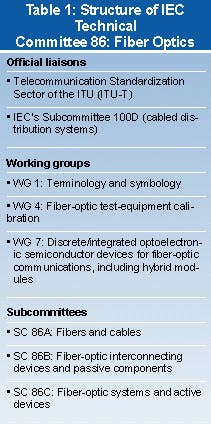The how and now of international test and measurement standards
The process takes time and money, but companies competing in global markets, the fiber-optic industry, and the community stand to gain from these emerging technology standards.
In fiber-optic telecommunications, change takes place at a revolutionary speed: yesterday's radical technology is often today's widespread application. In a field with few constants, standards development organizations (SDOs) work to establish specifications and regulations that will ensure product quality and safety. For standards to be relevant, SDOs have to keep pace with technological developments. Most organizations recognize that product lifecycles are short, and therefore standards work is continuous.
By their very nature, standards are public information; anyone can have access to them. Like most published information, however, this documentation is not always free. Time and money--not to mention research, negotiation, and consensus building--go into developing standards. Experts from all over the world gather at regular SDO meetings to propose, review, and recommend approval of the standards that their companies will follow. Thus, organizations that produce standards charge their members significant sums to participate in this important process.
Standards committees address a wide variety of issues; different regions of the world have concerns based on specific infrastructure and market needs. For example, Japan's telecommunications infrastructure tends to favor dense fiber plants, while U.S. infrastructures are more varied. All the same, businesses in most countries have certain pressing issues in common, such as the need to implement strategies to cope with increasing demand. International standards encourage world trade and economic efficiency by removing technical barriers to trade. Key areas in fiber-optics test and measurement where SDOs are working to establish standards include polarization mode dispersion (PMD), wavelength-division multiplexing (WDM), optical amplifiers, and fiber specifications.
In the United States, the Telecommunications Industry Association (TIA), Telcordia Technologies (formerly Bellcore), and the Institute of Electrical and Electronics Engineers (IEEE) perform standards work for several industries including fiber-optic telecommunications. In terms of international organizations, there are two major bodies for developing voluntary standards: the International Electrotechnical Commission (IEC) and the International Telecommunication Union (ITU), both based in Geneva, Switzerland.
As the international standards and conformity assessment body for all fields of electrotechnology, the IEC not only addresses telecommunications, but also electronics, magnetics and electromagnetics, electroacoustics, energy production, and distribution. The IEC is product-oriented, rather than application-oriented. Approximately 50 countries are full members of the IEC; these members have equal voting rights and are represented by national committees. As much as possible, the national committees--each of which is responsible for representing the public and private electrotechnical interests in its country--work together to provide consensus at the international level. Associate member countries have observer status but no voting rights. By setting international standards and producing technical reports, the IEC provides a solid foundation for national bodies to set regulatory standards. Adherence to these standards, however, is voluntary, even if a country is an IEC member.
The IEC has formal links with several other international standardization bodies, including the International Organization for Standardization (ISO), the ITU, the World Trade Organization (WTO), and the European Committee for Electrotechnical Standardization (CENELEC). At the telecommunications level, many TIA members also serve as active members of the IEC. In 1996, the IEC and the CENELEC ratified a formal agreement to facilitate standards harmonization.
Major decision-making at the IEC follows a recognized chain of command, from the governing committee, known as the IEC Council, to other administrative bodies, then on to the technical committees (TCs), subcommittees (SCs), and working groups (WGs). As many as 200 TCs and SCs and about 700 WGs gather information from 10,000 experts worldwide. These experts prepare the technical documents necessary for drafting international standards. Any member country, or organization with official links to the IEC, can contribute to these standards.The IEC TC 86, Fiber Optics committee works to establish fiber-optic communication system and component specifications, and test and measurement methods. Its structure is shown in Table 1.
The second major international standards body, the International Tele communication Union (ITU), is a multilateral United Nations organization that brings governments and the private sector together to coordinate global-telecommunications networks and services. In contrast to the IEC, the ITU deals mainly with applications. The ITU is composed of three sectors: radio communication (ITU-R), telecommunication standardization (ITU-T), and telecommunication development (ITU-D).The ITU-T develops voluntary standards to address technical, operating, and tariff issues in global telecommunications. Fourteen study groups, each composed of representatives from member countries, work on topics and make recommendations for standards. Table 2 identifies the current study groups working to establish telecommunications standards.
Table 3 lists the topics that Study Group 15, the group formed to work on transport networks, systems, and equipment issues, is currently reviewing in an effort to establish industry standards and regulations.Every four years, the World Telecommunication Standardization Conference (WTSC) assembles ITU members to define general policy for the sector, establish study groups, and approve a four-year work program. The next WTSC is scheduled for Sept. 27-Oct. 6 in Montreal, Canada.
The IEC tc 86 on fiber optics is developing PMD-related standards. PMD is a dispersion phenomenon that is statistical in nature: random coupling between polarization states governs PMD values, making the phenomenon difficult to quantify. PMD affects singlemode fiber at high transmission rates, which means that most businesses and countries find it in their interest to address PMD-related problems.
The ITU (through Study Group 15, Question 15: characteristics and test methods of optical fibers and cables) is in the midst of choosing a reference test method for measuring PMD; both Jones Matrix Eigenanalysis (JME) and Poincaré Sphere Analysis (PSA), two equivalent polarimetric methods, are in the running. The fixed analyzer method (also referred to as the wavelength scanning method) and the interferometric method, while valid, will not be retained as the reference test method.
A technical report (IEC 61282-3) on calculating PMD in fiber-optic systems has been drafted. Published standards include "PMD Measurement Techniques for Singlemode Optical Fibers" (IEC 61941), which outlines commercially available test methods. Currently under review are proposals for statistical PMD cable specifications, PMD test methods for optical amplifiers, and PMD measurement methods for optical components.
Other recent work is focused on the following areas:
- Dispersion compensation, IEC 61282-5.
- PMD on digital and analog systems, including system test procedure IEC 61282-3.
- Development of PMD power penalty relationships.
WDM is another area where SDOs are working to establish standards. A relatively new technology, WDM, which involves transmitting multiple signals over a single optical fiber, has brought about several new concerns for the telecommunications industry, such as spacing between wavelength signals, new transmission windows, and wavelength accuracy. At last October's IEC meeting, a new sector board, SB 4, was formed to address the following infrastructure issues:
- Standardization of installation conditions and instructions.
- DWDM techniques for optical amplifiers, fibers (important also in ITU-T).
- Digital-subscriber-line (DSL) installations and new passive infrastructures (important also in ITU-T).
- Major fiber changes' influence on standards.
- Twisted-pair for outdoor applications, optimized for ADSL.
- New developments in multimedia home cabling.
In addition to deploying WDM technology, service providers are in creasingly turning to the long-band (L-band) to transmit signals on existing infrastructures. The ITU, which defines the wavelength grid for signal transmission, has defined the L-band as up to 1625 nm, or 16xx nm with xx <25.
Another concern is the attenuation (also referred to as insertion loss) of DWDM devices. Document IEC 61074 from IEC sc 86b will be used for definition of terminology and consistency. The same committee is working with the ITU-T on a definition of center frequency.
A key enabling technology for WDM and long-haul applications is the optical amplifier. Optical amplifiers, which are placed along a link to provide linear amplification of a signal (or several signals in the case of WDM), are more efficient than the optoelectronic devices needed for regenerative signal repeaters. In addition, optical amplifiers represent key next-generation technologies when used in preamplification applications requiring low noise and in gain applications requiring high power.
Generic specifications for optical amplifiers are found in IEC document 61291-1. Also under discussion is IEC 61291-4, a performance specification template for multichannel optical amplifiers. The standards organizations are taking a "black box" approach to product specifications. Ideally, these specs would be provided independently of application details.
The following definitions are given in IEC 61291-4:
- Automatic gain control.
- Automatic gain control operating input power range.
- Gain equalization and clamping criteria.
- Spectral hole criteria.
Several other topics are under discussion in IEC SC 86C, given that this is a crucial future technology. WGs within the subcommittee are working on defining reflectance and reliability testing, establishing gain and noise figures, and setting performance specifications. One such example is in IEC 61290-1-3 Gain by Optical Power Method, which demonstrates that the gain measurement for a single channel taken with a power meter and bandpass filter would be as valid a measurement as one taken with an optical spectrum analyzer. This is a highly cost-effective approach to gain measurement in production, provided that values can be verified periodically with an optical spectrum analyzer. In addition, PMD concerns affect optical amplifiers; IEC 61290-11-1 is a working document that addresses this issue.
There is a major project at the IEC to update the way in which fiber specifications are made, including standard test methods. sc 86a, wg 1 on optical fibers is responsible for this dossier. Documents in the IEC 60793-1-x series propose that fiber specifications be organized by attribute. Fiber generic specification was discussed. The restructured test methods are organized by fiber attributes.
Recently, fiber manufacturers have learned how to make low-water-peak fibers, and the standards organizations have been working on setting specifications. For instance, one problem is that not all fibers that start off with a low water peak will stay that way over their lifetime. In recent developments at the IEC, it was proposed that the average attenuation ax at wavelength X, after aging, be less than or equal to the value specified at 1310 nm. X is between 1383 nm (the water peak) and 1480 nm. At last October's IEC general meeting, further clarification was provided on the wavelength specifications versus the attenuation values. This text will be added to IEC 60793-2 for discussion at the next meeting.
For more information on the test and measurement work in progress at the international SDOs visit their Websites at www.itu. int for the ITU and www.IEC.ch for the IEC. Members of these organizations are working to establish fiber-optic standards and regulations that will improve industry efficiency, promote world trade, and ensure product and service quality. Although ITU standards are voluntary, many nations and companies comply because standards facilitate network interconnectivity, which makes it possible to provide services around the world. By making use of standards, companies can gain a significant competitive edge in their respective markets.
André Girard is a senior member of the technical staff and Sovita Chander is a technical editor at EXFO Inc. (Vanier, Quebec, Canada).


